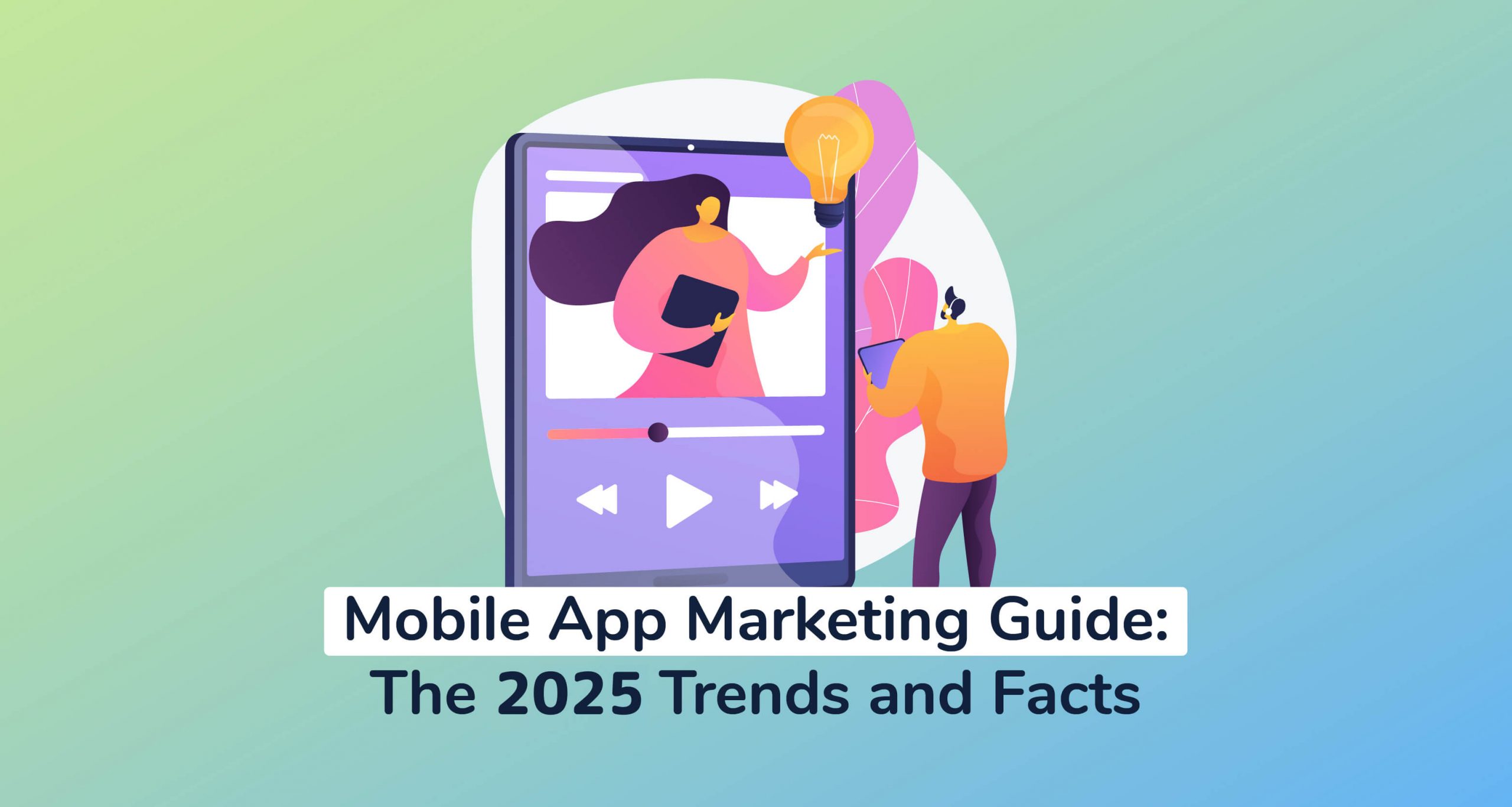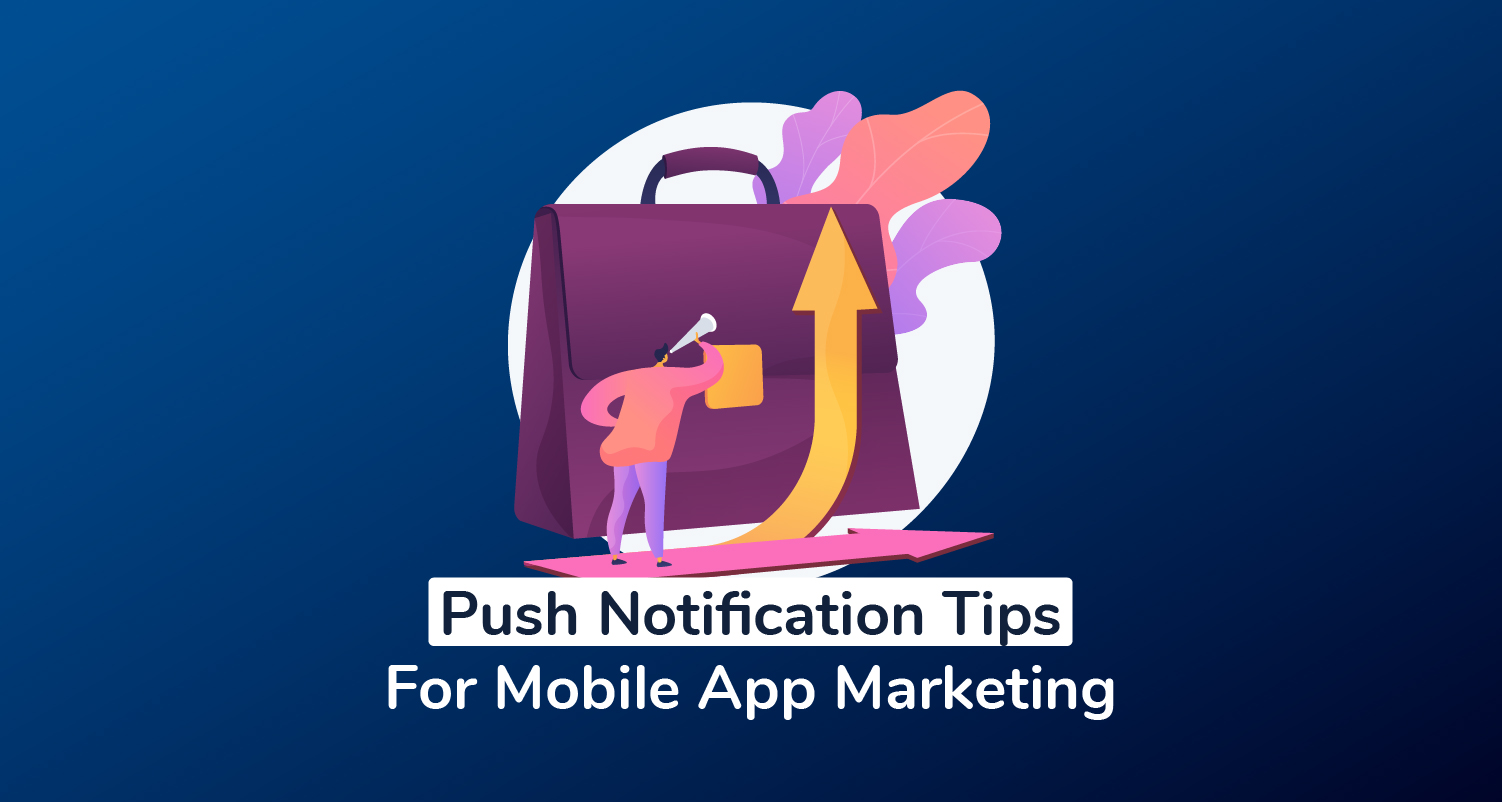
Launching A Mobile App: The Complete Guide To Early Success
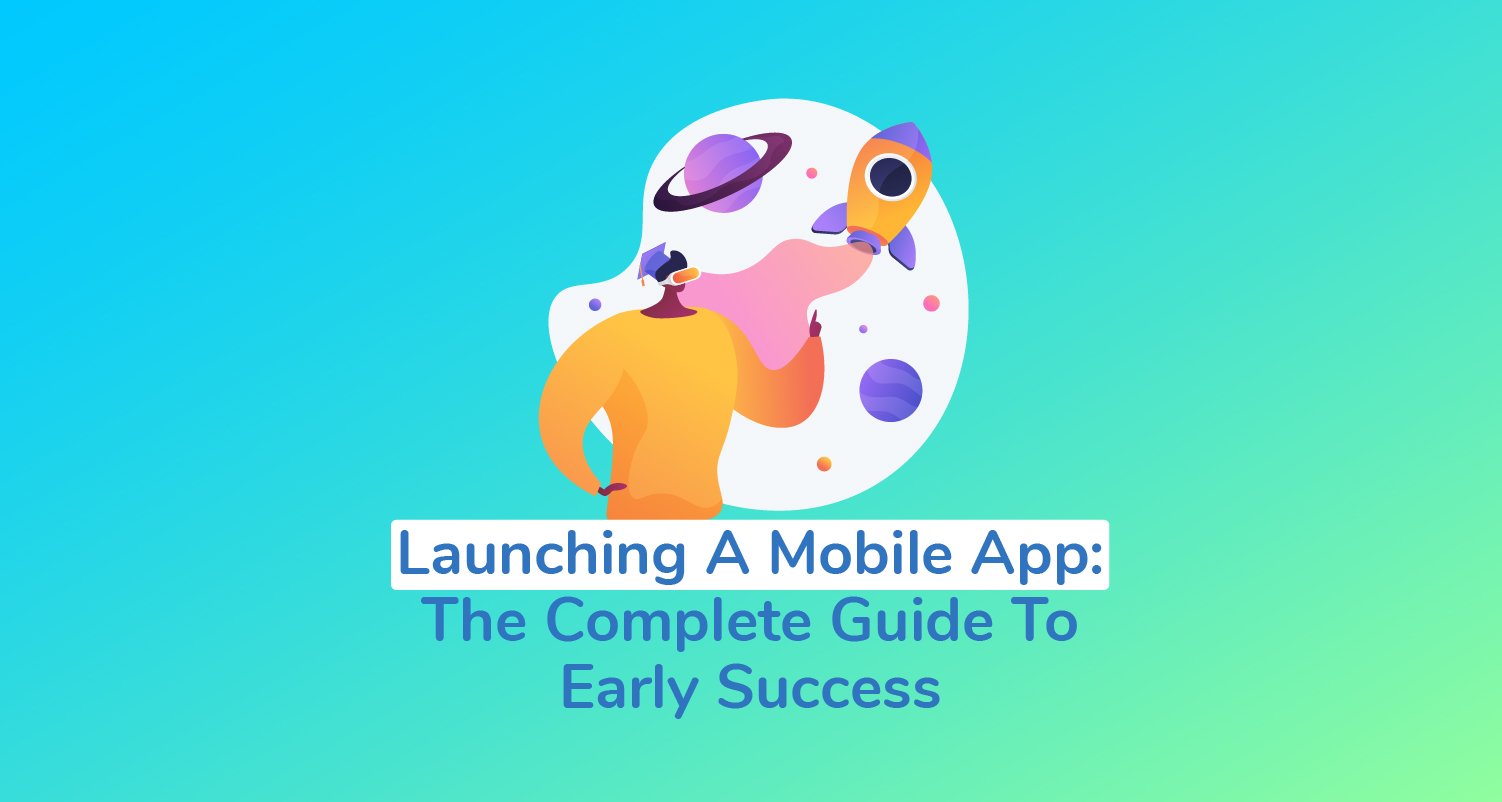
Launching an app is by far one of the most exciting moments for app developers and app owners. The mobile app launch is like a long-awaited sigh of relief to culminate the commonly tedious mobile app development journey.
Table of Contents
- The Failure Rate After Launching A Mobile App
- Launching An App In The Current Mobile App Market: What To Expect
- #1. Competition From Pre-Existing Mobile Apps
- #2. Competition From Newly Launching Mobile Apps
- #3. The Share Of Potential Users
- #4. How Mobile App Marketing Fits Into The Scene
- The Ultimate Mobile App Launch Strategy: 10 Steps You Must Take To Drive App Success
- #1. Come Up With A Creative App Name
- #2. Develop An Attractive App Icon
- #3. Create Compelling Screenshots
- #4. Do Proper Keyword Research
- #5. Write A Compelling App Description
- #6. Promote With Viral Videos
- #7. Make The App Famous With A PR Campaign
- #8. Localize/Make The App International
- #9. Push For App Reviews
- #10. Go Social
- Key Takeaways
The irony about launching a mobile app is, the process itself is more like a double-edged sword.
On one hand, we can agree that a mobile app launch is inarguably one of the most exciting milestones for app developers and app owners. It marks the culmination of a hectic mobile app development process and the beginning of a new business journey. This is when you finally get the chance to fully commercialize your mobile app idea.
Here’s the kicker, though – while your mobile app launch is, by all means, a huge achievement, what comes next is substantially more challenging than mobile app development, design, and testing combined.
This is one complexity that exceedingly dampens the mobile app launch events. As your app gets published on the iOS App Store or Google Play Store, it suddenly dawns on you that hacking the mobile app market may not be as easy as previously assumed.
The Failure Rate After Launching A Mobile App
According to some industry reports, as many as 80% of mobile apps fail within the first year of their launch. Shocking indeed – but, it gets worse. A special report by Gartner suggests that only 0.01% of consumer mobile apps proceed to achieve financial success after launch.
Well, that’s a pretty slim margin. But, get this – while I’m not one to brag, it just so happens that we’ve helped thousands of our partner apps make the success cut. And from the resultant data collected across over half a billion app downloads, PreApps has developed the ultimate mobile app launch strategy.
Our advanced campaign trials over the years have proven that, in total, it takes about 10 steps to hit the ground running during an app launch. We now invite you to read along and discover how to leverage them across all the popular types of mobile apps – Android apps, iOS apps, freemium apps, paid apps, native apps, etc.
You can go ahead and scroll down to explore the specifics in the main section of the article – you’ll find that we’ve broken down the marketing strategy into its 10 constituent steps.
For the sake of clarity, though, we insist that you start off with the following market status report. At least then you’ll have a better idea of the stakes you’ll be dealing with before, during, and after the mobile app launch.
Launching An App In The Current Mobile App Market: What To Expect
To achieve early mobile app success, the fact of the matter is, you’ll need a formula for winning over potential users as soon as the app is published on the App Store. This is especially difficult as you’ll be competing against millions of other mobile apps across a wide range of industry categories.
#1. Competition From Pre-Existing Mobile Apps
If you’re planning to launch your mobile app on the iOS App Store, for instance, you’ll be greeted by a full house of more than 2.2 million mobile apps. The competition is even stiffer on the Google Playstore, as it already hosts more than 3.4 million Android apps.
But, that’s not all. In addition to the millions of already established App Store apps, you’ll be competing with thousands of new mobile apps that happen to be launching on the same day as yours.
#2. Competition From Newly Launching Mobile Apps
It turns out that both Apple and Google are ever busy with mobile app launches, as they typically process hundreds of newcomers per hour. There’s not a single moment that you’ll have all the app launch limelight to yourself.
You see, on a good day, you could be hitting the App Store with about 1,500 other debutants – while on a bad day, the number could rise to a whopping 4,000 or more.
The average number of mobile apps published on the App Store on a daily basis usually ranges between 1,400 and 4,000. This ultimately adds up to tens of thousands of mobile app launches per month.
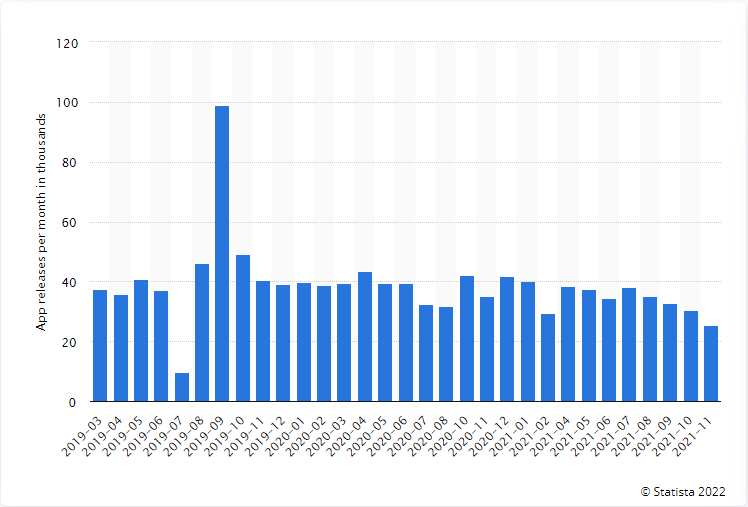
The numbers are even higher on the Google Play Store, where mobile app developers typically launch over 6,000 Android apps per day.
During the month of November 2021, for example, the Google Play Store published a total of 60,000 apps – which, surprisingly, happens to be a huge drop from the highs of 134,500 recorded in May 2019.
The complications, however, don’t end there.
#3. The Share Of Potential Users
If you’re seeking solace in the huge volume of smartphone users – hoping that it’ll ease the competitive pressure – you might want to lower your expectations. While there are now over 1 billion mobile devices running iOS and more than 3 billion on Android, only a fraction of them are open to trying out new mobile apps every now and then.
In the US, for instance, only 5% of smartphone users install more than 8 mobile apps per month, while 7% download 5-7 apps, 5% settle for 4 apps, 8% try out 3 apps, 11% install 2 apps, and 13% tend to download only a single app.
None of these can compare to the whopping 51% of users who claim to download zero mobile apps per month. So, it’s safe to conclude that during the mobile app launch, you’ll be scrabbling for a very limited chunk of potential users.
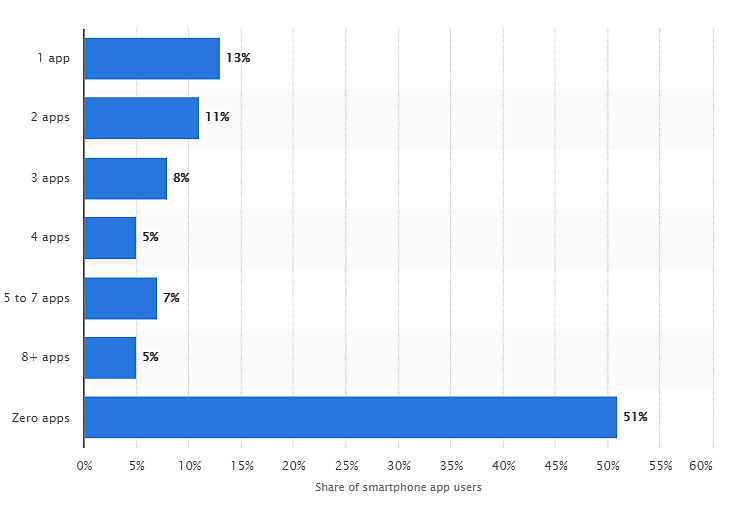
What does this mean for you?
#4. How Mobile App Marketing Fits Into The Scene
Well, in such a highly competitive mobile app market, the high-stakes battle for popularity ultimately comes down to your mobile app marketing strategy. You have to piece together a holistic marketing strategy that capitalizes on multiple app promotions to engage and convert potential users.
You could, for example, set up an omnichannel marketing strategy that leverages App Store Optimization, along with social media, landing pages, push notifications, and paid ads.
But, don’t get me wrong. I’m not advising you to kickstart app marketing during the mobile app launch. After successfully promoting over 3,300 apps, I’ve confirmed with utmost certainty that the market responds best to the mobile apps that get people going before the D-day.
As such, you should set up a comprehensive marketing strategy that begins with prelaunch app marketing to generate buzz, after which you should engage app launch marketing tactics during the actual launch, followed by post-launch app user acquisition and app user retention campaigns.
This is the type of mobile app marketing approach that, in fact, catapulted Pokemon Go to the top in 2016.
At a time when the rate of daily mobile app releases had peaked, Pokemon hit the ground running and even managed to break App Store’s record for the number of installs in the first week of release. So impressive was its run that, within one week of launching, Pokemon had generated $14 million in revenue. And the rest, as they say, is history.
Now, that is the type of early app success you should replicate when launching a mobile app. Here is a step by step tutorial that’ll get you started:
The Ultimate Mobile App Launch Strategy: 10 Steps You Must Take To Drive App Success
#1. Come Up With A Creative App Name

It all starts with the app name.
But then again, what exactly makes up a good mobile app name?
What you choose to title your mobile app doesn’t only influence its overall attractiveness. It significantly determines how potential users discover it in the first place – since the App Store search algorithm uses even the factors in even the app keywords in its search result ranking.
So, put your investigative hat on, and conduct in-depth keyword research to find the most ideal ones to incorporate. About two or three solid ones should work, as opposed to spamming the mobile app title with all sorts of terms.
The best possible outcome is achieved by creatively combining the app keywords to form a name that not only explains what the mobile app is all about but also optimizes it accordingly for the App Store search algorithm.
Come to think of it, that’s partly how we managed to push a social networking app to the top spot after its launch. By embedding the keywords “Social Group”, we named it “TagFi-Social Group”, and subsequently outranked even the likes of Facebook.
#2. Develop An Attractive App Icon
The title will only get your mobile app discovered. After that comes another tough nut to crack – you have to create a good first impression to pull in the prospects.
Considering iOS app users spend on average of 10 seconds on the App Store landing page, you ought to use a good app icon to capture attention and drive engagement.
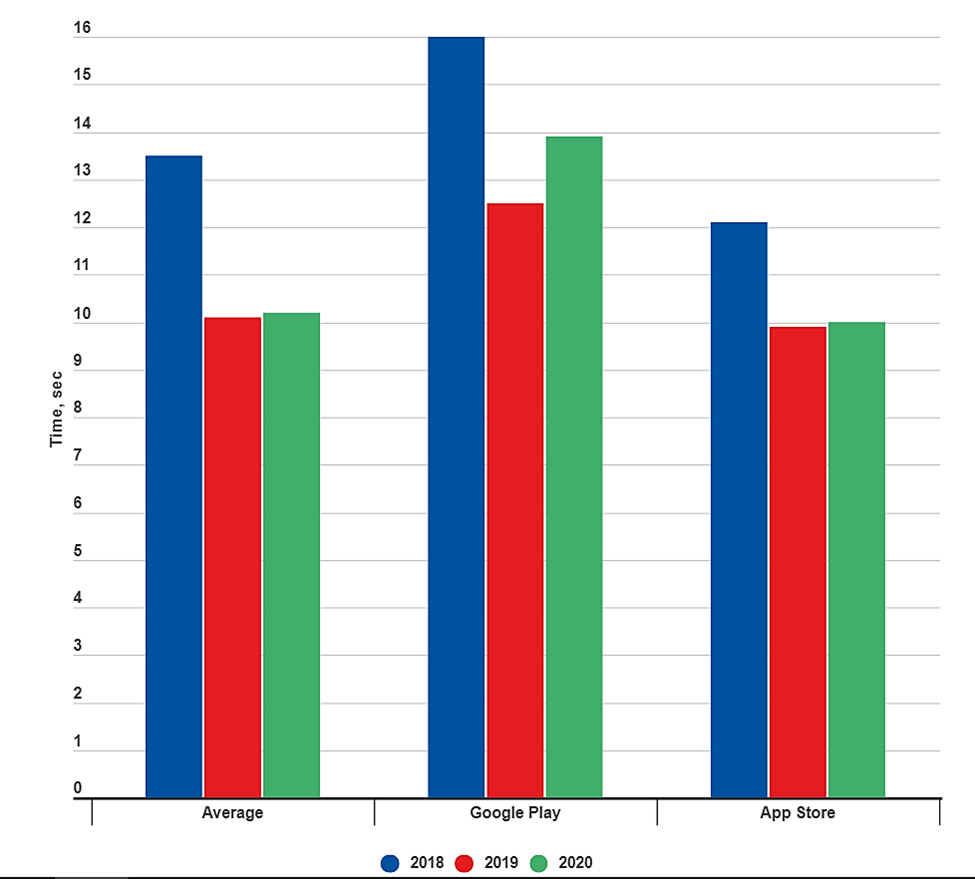
So what makes up a good mobile app icon?
A perfect one should be simple but unique and distinctively noticeable right off the bat.
Take a look at Instagram’s icon, for instance. Its vibrant colors and well-designed outline pretty go a long way to helping it stand out from the rest of the apps listed on the search results.
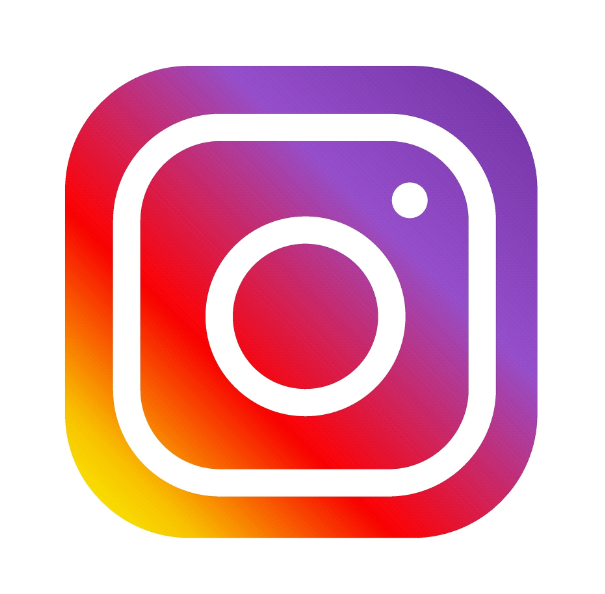
To replicate this level of finesse, start by critically analyzing your competitors’ icons. The elements you choose for your icon design should be way more elegant and captivating.
But then again, while you’re at it, ensure that the final design doesn’t turn out to be a bit too overwhelming. Keep it simple and stylistic with a positive feel.
#3. Create Compelling App Screenshots

Now, let’s imagine that you’ve won a couple of hearts through your app’s icon. How will you compel them to commit to your mobile app?
Quite simply, you might want to capitalize on the one thing that takes up most of the App Store landing page experience. This is we you take into account the fact that in 90% of the App Store page sessions, users typically don’t proceed past 10% of the landing page scroll depth – which, for your information, is the section that prominently features the app screenshots.
Other reports suggest that about 70% of the users tend to scroll up to the point of viewing the full screenshots.
But, they rarely scrutinize all of them. In the end, most of the people form a judgment about the mobile app based on just the first two screenshots – while only 13% bother to proceed to explore other screenshots and sections.
This essentially leaves you with one principal option – telling it all with the app screenshots. Each screenshot should simulate its own unique story in a persuasive, engaging, and compelling manner.
Put yourself in the shoes of your target user and think about their precise interests. What needs will they be seeking to fulfill with your mobile app? Which features will they be seeking?
Use that info to pick out the most outstanding sides of your mobile app that showcase the main functions and user flows. The subsequent screenshots should comprehensively describe your mobile app’s experience using enthralling graphics, which ought to be carefully selected from a series of engaging shots.
When everything’s ready to roll, try to enhance the final shots accordingly, and then arrange them systematically in a logical order. You can also supplement them with relevant single-line text descriptions that give potential users a general idea of what to expect.
#4. Do Proper Keyword Research

All things considered, keyword research is the foundation of the entire App Store Optimization framework.
What you select for your mobile app, at the end of the day, determines its overall search result ranking. That means your keywords can make all difference in the volume of organic App Store downloads that you manage to generate
Contrary to the common misconception, though, the keyword selection process is not that simple. It takes more than just guessing random terms to find the best ranking keywords for optimizing your mobile app’s landing page.
That said, the logical approach here is to first understand the natural search trends. Use analytical tools to find out exactly how users discover your competitors’ mobile apps based on their corresponding interests. By assessing the number of mobile apps ranking on each popular search term, you’ll be able to identify various keyword opportunities to maximize on.
And while you’re at it, don’t limit yourself to just one keyword subcategory. It just so happens that the App Store can accommodate up to 100 keyword characters. Therefore, consider implementing a dynamic keyword structure that ranks your app favorably in multiple related search groups.
Also, remember to review your entire keyword setup from time to time. This helps you adjust them according to the progressive market changes.
A great ASO tool that could help you with that is PreApps AppReport. It comes in the form of a free cloud-based App Store Optimization intelligence platform, capable of diving deep into your App Store and Google Play Store pages to check on your ASO parameters.
And that’s not all. You even get recommendations for improving your ASO status.
#5. Write A High Converting App Description

Although only 1% of App Store users admit to expanding the description, you still need to write a very compelling copy. 52% of iOS and Android device owners insist that the app description plays a major role on the landing page.
And how exactly do you rope them in with a compelling app description?
Well, in high-level mobile app marketing, we have this special copywriting formula that we’ve tested and proven. It goes by the name AIDA, and it entails using four sequential approaches to draft a convincing piece.
For starters, the app description should capture your readers’ Attention right from the beginning. Try to captivate them within, say, the first 200 characters.
The next bit is all about keeping them Interested. This is where you describe the principal problem your mobile app seeks to solve.
That should lay the groundwork for the third step, which seeks to make the reader Desire your app. You can achieve that by outlining how they stand to benefit from the mobile app, without necessarily diving deep into the technical features.
Finally, conclude the whole thing by encouraging readers to Act. Hit them with an impactful line like “Launch The Game To Earn Points!”. These are the types of Call-To-Action that ultimately drive conversions.
#6. Promote With Viral Videos

How do I make a mobile app go viral?
Video marketing. That’s, by far, the most effective marketing strategy when you want your campaign to go viral on social media.
Besides the fact that videos engage audiences twice as much as images and text, they happen to be the most widely shared material on social media. It is this deep level of engagement that compels 80% of app video viewers to download an app after watching its branded video.
So, don’t restrict yourself to the app demo video intended for the App Store – you should, instead, consider creating additional more interesting videos for app promotion on social media.
You just need to creatively come up with a brief but extremely captivating video concept, shoot the whole thing in high-definition graphics, and then publish the video on social media. The potential reach here could be immense – capable of reaching even millions of viewers a week.
Now, this requires a special level of finesse since it’s not your regular video. You have to compose something that can generate shares from even the least active social media users, which should then lead to increased app downloads as the viewership grows.
How do you achieve that?
In essence, you should prioritize three things. The videos should not only be exciting, but also educative and inspirational. What’s more, they should harmoniously integrate various media elements – such as background music, featured text, plus voiceovers – to closely engage the viewers and urge them to get the app immediately.
#7. Make The App Famous With A PR Campaign

The quickest way to stand out from the competition is to make your mobile app a celebrity. And that can only come from a well-coordinated PR campaign.
For instance – you may have heard about Virgin’s interactive PR campaign that saw the app’s Australia-based users compete against each other to win $200K.
The PR campaign, dubbed “Game of Phones”, intuitively combined gamification and real-life rewards. Users got both physical and digital incentives while playing the game in-app, on Virgin’s mobile website, as well as in physical stores – a strategy that paid off big time!
In terms of numbers, this brief PR campaign resulted in:
- 40K active users
- 14K+ users entering brick and mortar stores
- 44% of users actively engaged with the game in Sidney
Don’t limit yourself to contests and giveaways, though. There are many other different ways to promote a mobile app with a PR campaign.
You could, for example, distribute an interesting app press release to established media platforms that enjoy large audience bases.
PreApps has used this strategy on several occasions to secure extensive media coverage for a wide range of mobile apps. The journalists that we reach out to help spread awareness by running stories based on the details outlined in the app press release.
That is more or less the same app marketing strategy that Security Master used to popularize its mobile app before and during its launch. It gained immense fame after it was promoted and recognized on the Entrepreneur, The Next Web, The Huffington Post, and so forth.
Partnering with an “influencer” is another way to generate lots of buzz around your mobile app.
You could, for instance, learn from the gaming app Best Friends, which partnered with several Instagram influencers to build awareness across social media.
And that’s not all. The company also asked gaming critics to review the mobile app on their personal YouTube channels. This subsequently generated so much buzz that even big names like PewDiePie featured the mobile app on a video, which then ended up garnering over 2.5 million views and 50,000 direct app installs.
#8. Localize/Make The App International

The good thing about the App Store’s global network is that it’s made up of many distinct territories. Although serves the world at large, it also happens to independently cater to more than 150 countries in 40 diverse languages.
Since each of these local App Store versions has its own unique vocabularies and search trends, an app that’s performing well in one country could be ranking poorly in another territory.
Hence, it’s prudent to configure your App Store Optimization for each of your target localities.
#9. Push For App Reviews
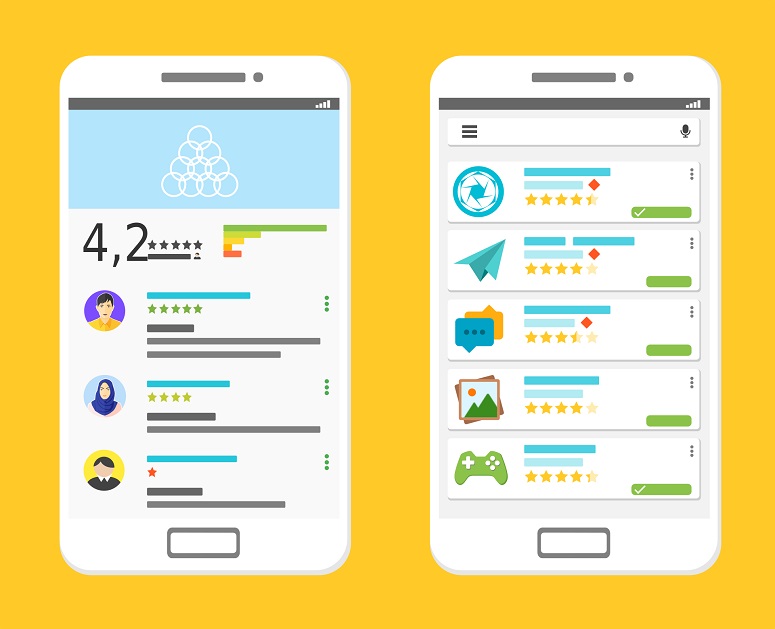
To help users discover the most efficient mobile apps, the App Store search algorithm factors in even the app reviews. It assesses not only the number of reviews but also the corresponding ratings left by users.
Therefore, you should consider enhancing your app store optimization further by increasingly rallying users to drop positive reviews. Well-timed push notifications are particularly handy when it comes to this.
Over time, you’ll notice that such app reviews are also great for convincing potential users, plus collecting genuine feedback about the app’s features.
#10. Go Social
According to a 2019 Mobile App Usage Survey by GoodFirms, a majority of people download a new app based on recommendations from friends or family members.
Another medium that features quite prominently is social media – as 42% of the respondents made their discovery through social media ads, while 34% relied on their friends’ social media posts. So, in essence, you could say that social media drives a whole lot more than just 42% of the app discovery instances.
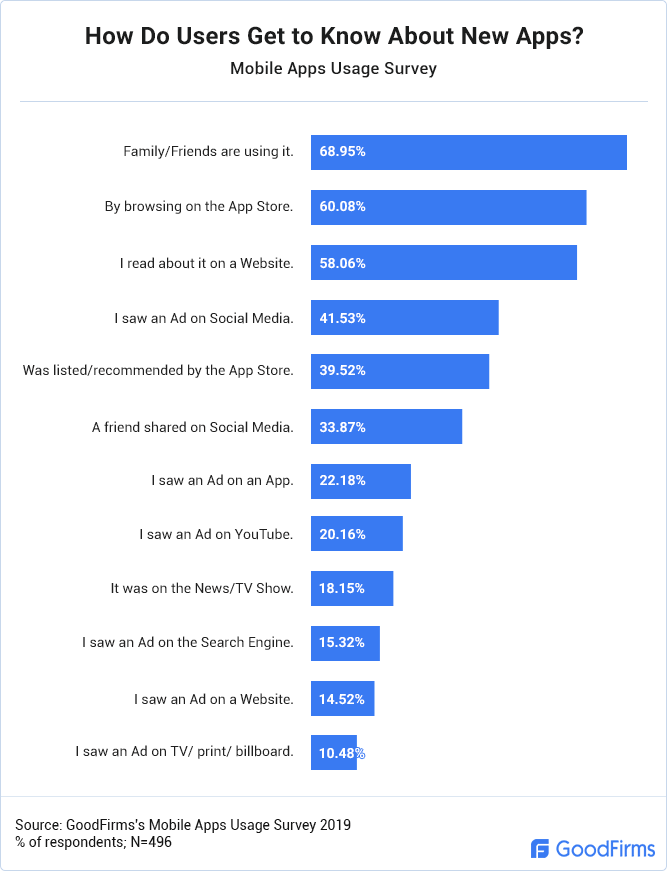
With that in mind, it would be unwise to underestimate the potential impact of social media app promotions on your mobile app launch.
You could start off with organic engagement as part of your prelaunch app marketing. And if you’re consistent with your engagement, you’ll have a solid following by the time you launch the mobile app.
At that point, you could go ahead and supplement your organic effort with paid social media ads. The likes of Facebook and Twitter are exceptionally ideal for such campaigns, as they offer intelligent targeting capabilities for app user acquisition.
Key Takeaways
Overall, you might want to keep in mind that:
- As many as 80% of mobile apps fail within the first year of their launch.
- Gartner suggests that only 0.01% of consumer mobile apps proceed to achieve financial success after launch.
- If you’re planning to launch your mobile app on the iOS App Store, you’ll be greeted by a full house of more than 2.2 million mobile apps.
- The competition is even stiffer on the Google Playstore, as it already hosts more than 3.4 million Android apps.
- The average number of mobile apps published on the App Store on a daily basis usually ranges between 1,400 and 4,000. This ultimately adds up to tens of thousands of mobile app launches per month.
- The numbers are even higher on the Google Play Store, where mobile app developers typically launch over 6,000 Android apps per day.
- During the month of November 2021, the Google Play Store published a total of 60,000 apps – which, surprisingly, happens to be a huge drop from the highs of 134,500 recorded in May 2019.
- In the US, only 5% of smartphone users install more than 8 mobile apps per month, while 7% download 5-7 apps, 5% settle for 4 apps, 8% try out 3 apps, 11% install 2 apps, and 13% tend to download only a single app.
- 51% of users claim to download zero mobile apps per month.
- You have to piece together a holistic marketing strategy that capitalizes on multiple app promotions to engage and convert potential users.
- You should set up a comprehensive marketing strategy that begins with prelaunch app marketing to generate buzz, after which you should engage app launch marketing tactics during the actual launch, followed by post-launch app user acquisition and app user retention campaigns.
- Consider creatively combining the app keywords to form a name that not only explains what the mobile app is all about but also optimizes it accordingly for the App Store search algorithm.
- Considering iOS app users spend on average of 10 seconds on the App Store landing page, you ought to use a good app icon to capture attention and drive engagement.
- A good mobile app icon should be simple but unique and distinctively noticeable right off the bat.
- In 90% of the App Store page sessions, users typically don’t proceed past 10% of the landing page scroll depth – which, for your information, is the section that prominently features the app screenshots.
- 70% of the users tend to scroll up to the point of viewing the full screenshots.
- Most of the people form a judgment about the mobile app based on just the first two screenshots – while only 13% bother to proceed to explore other screenshots and sections.
- By assessing the number of mobile apps ranking on each popular search term, you’ll be able to identify various keyword opportunities to maximize on.
- PreApps AppReport is a free cloud-based App Store Optimization intelligence platform, capable of diving deep into your App Store and Google Play Store pages to check on your ASO parameters.
- Only 1% of App Store users admit to expanding the description.
- 52% of iOS and Android device owners insist that the app description plays a major role on the landing page.
- The app description should first capture your readers’ Attention. The next bit is all about keeping them interested by describing the principal problem your mobile app seeks to solve. The third step drives Desire by outlining your app’s benefits, while Act comes last in the form of a CTA.
- Besides the fact that videos engage audiences twice as much as images and text, they happen to be the most widely shared material on social media.
- 80% of app video viewers are compelled to download an app after watching its branded video.
- To help users discover the most efficient mobile apps, the App Store search algorithm factors in even the app reviews.
- According to a 2019 Mobile App Usage Survey by GoodFirms, a majority of people download a new app based on recommendations from friends or family members.
- 42% of the app users made their app discovery through social media ads, while 34% relied on their friends’ social media posts.
- Since each of these local App Store versions has its own unique vocabularies and search trends, it’s prudent to configure your App Store Optimization for each of your target localities.
- Consider distributing an interesting app press release to established media platforms that enjoy large audience bases. The journalists will spread awareness by running stories based on the details outlined in the app press release.
- Viral marketing videos should not only be exciting, but also educative and inspirational.
Over To You
Getting your new mobile app off to a strong start will potentially set it on an upward trajectory, which is then bound to expand progressively over the long haul. The mobile app launch success stories we’ve sampled already prove that once you get the launch right and proceed to hit the ground running, mobile app growth comes almost automatically.
But, remember – the journey itself begins ahead of the mobile app launch. Instead of rolling out your app promotions after the mobile app launch, you should set up prelaunch app marketing campaigns to run parallel to the mobile app development process. That’s how you get the mobile app market warmed up for a mega app launch.
And no – you don’t have to overburden yourself with multiple hats at once. It’s impossible to effectively manage an omnichannel campaign while coordinating the mobile app development process.
So, tell you what – we’ll handle the marketing strategies on your behalf while you focus on building the app and getting the business going. Quit delaying your app’s success today and contact us. Our team of mobile app marketing specialists is on standby to make your mobile app growth plan a reality.
Newsletter
Don’t miss a thing! Sign up to receive daily news
Subscribe Newsletter




